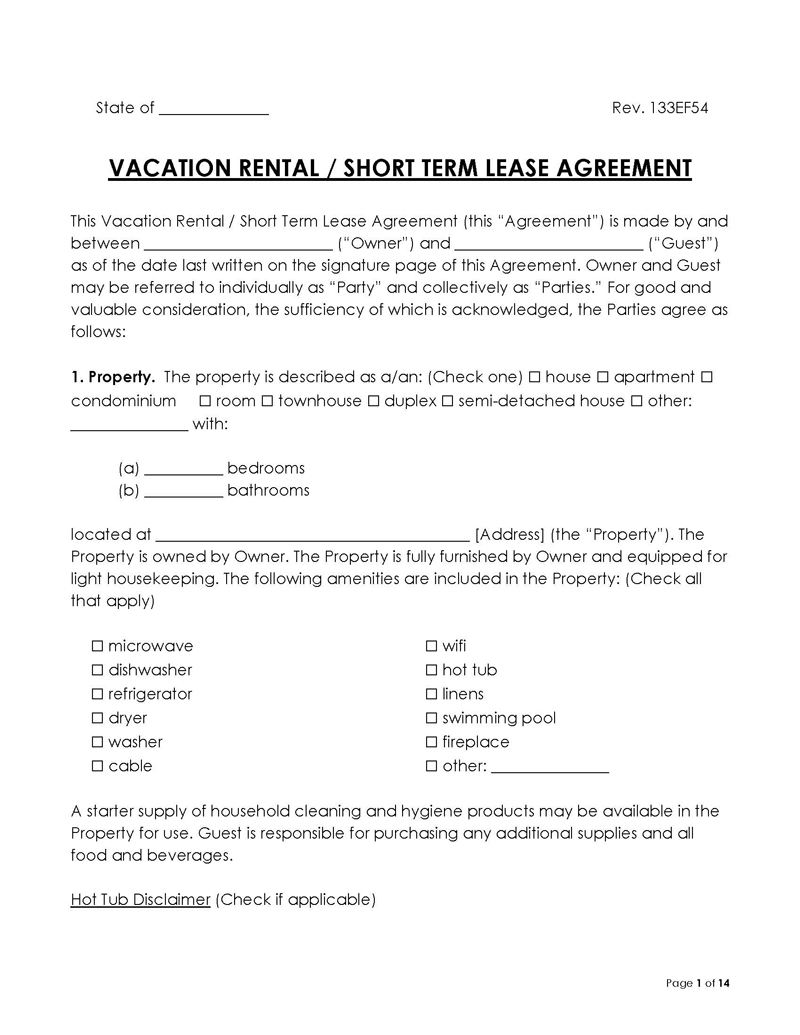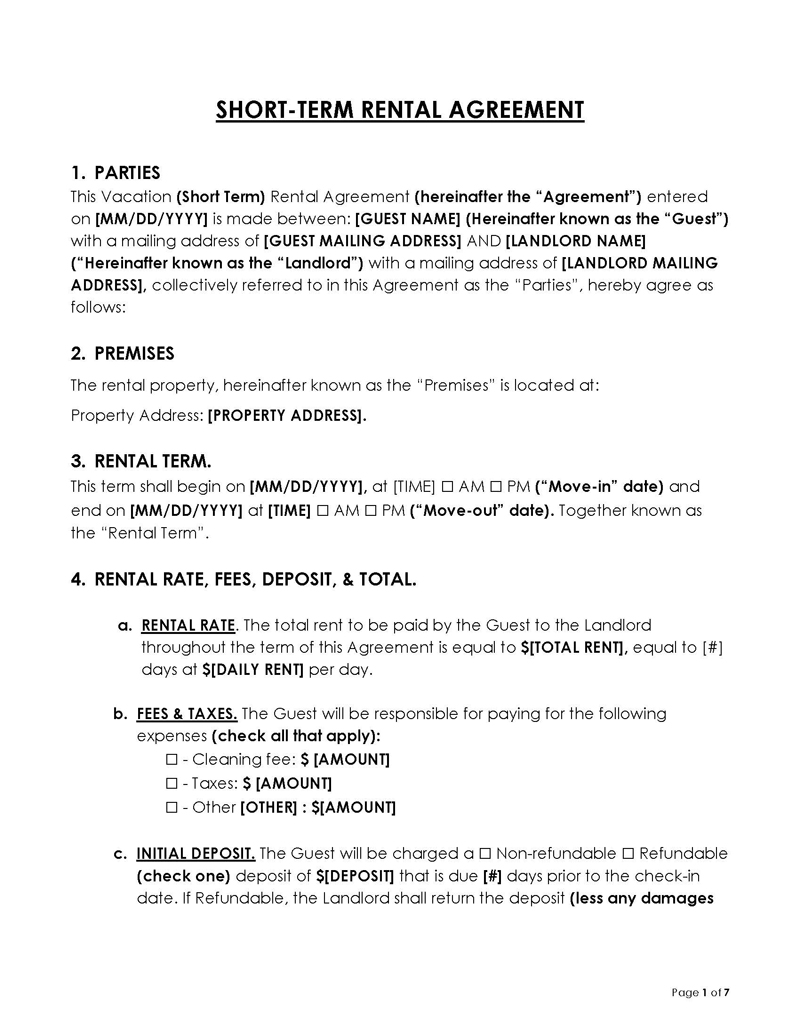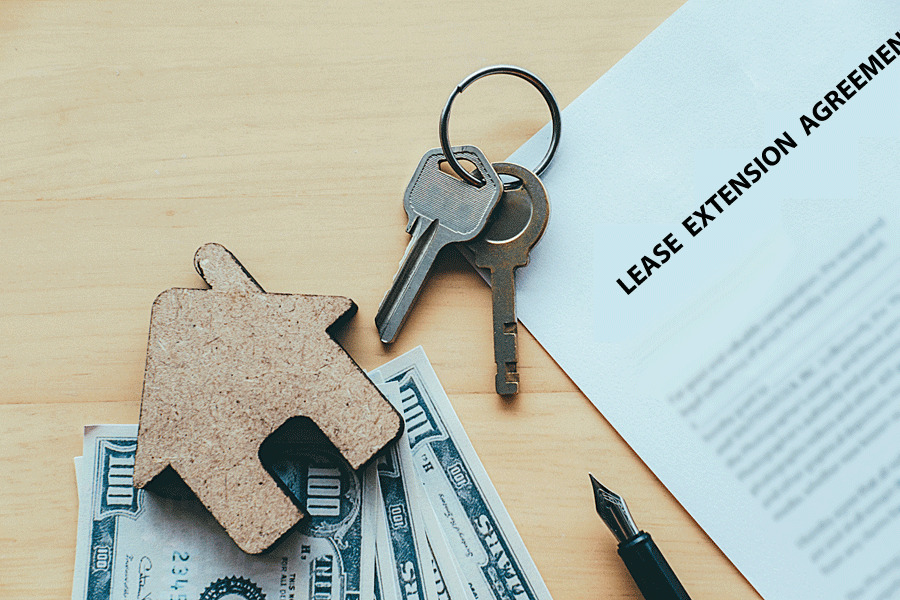A lease that lasts 30 days or less is called a Vacation Rental Agreement.
Setting exact terms for the rental period, this type of lease has to follow all state laws. Any rental property built before 1978 needs to have a Lead-Based Paint Form provided for potential tenants.
The vacation rental agreement differs from a standard lease. The landlord is responsible for all of the property’s services and utilities and any other property expenses. The agreement protects both the owner and the tenant if there are damages to the property or the unexpected cancellation of reservations.
It is usually used for stays that last just a few days or weeks and never longer than six months. A landlord who’s planning to use an online rental platform may be required to use a rental agreement with tenants, which provides legal protection for both landlords and tenants. Landlords also need short-term rental contracts if they want a tax exemption or want to claim a business deduction. (Taxes need to be paid when you rent your property for more than 14 days.)
Free Templates


What to Include in a Vacation Rental Agreement
The following should be included in your vacation rental agreement:
Date
Include the calendar date of when this agreement is entered. Usually, this is the same date as the signature date. Still, it can also be dated after the execution of the paperwork.
Include owner and guest details
Include the names of the short-term tenants and their addresses. (Their permanent home address is required to complete the identification process.) Also, include the landlord’s complete address, including street name, city, zip code, and state.
Describe the property and amenities
In the vacation rental agreement, describe what type of property your residence is, and details about basic things like the number of bedrooms and bathrooms. Ensure the guest knows about whatever special amenities the property has, such as a mini-fridge, hot tub, sound, or movie system.
Include rental period
The type of lease you’ll use depends on how long your guest will be staying.
- Fixed-term lease: Establish the lifetime of this agreement. Select “Fixed Term” if the property will be rented for a specific number of months, with a defined beginning and end. Provide the first calendar date and time and the final calendar date and time in the agreement.
- Month-to-month lease: Choose “Month-to-Month Lease” if your short-term rental property will be leased on a month-to-month basis. Provide the first date of the rental period and the number of days that the terminating party needs to give as notice that they will terminate the agreement.
Smoking policy
Your lease needs to inform your tenant of your policy about smoking:
- Prohibited: Inform tenants that smoking is not allowed anywhere on the short-term rental property.
- Permitted: Inform your tenants if some areas of the property will allow smoking and let them know where smoking is allowed.
Pets
Guests sometimes want to travel with their pets, and you need to delineate the specifics of your pet policy in the vacation rental agreement:
- Does not allow pets: Let the tenant know they can’t keep or live with pets on the premises.
- Allows pets: Inform the tenant if they are allowed to live with pets on the premises.
- Details on allowed pets: Define the maximum number of pets they are allowed, along with the maximum weight allowed for each pet.
- Pet security: You may decide to request a security deposit for allowed pets. In that case, document the dollar amount the tenant must deliver to you for each pet, and if this amount is not refundable.
Occupants
Write details about your policy regarding visitors as well as the total number of guests allowed on the rental property.
Quiet hours
Inform tenants of your policies regarding quiet hours. For example, you may want to select “No quiet hours” if units are not physically close to each other within the community. Tenants won’t need to be mindful of the level of noise produced.
If the rental property is in close proximity to others, “Quiet hours” are required of the short-term tenant during their stay. Let the tenants know this and make a note of the times when the tenant will need to keep noise at a minimum.
Parking
Provide information to your tenants about whether, when, and where they can park and if there’s an additional cost to do so:
- Landlord provided parking: Let your tenants know if one or more parking spaces accompany the short-term rental and if there’s an extra cost.
- Payment term: Inform the tenant if the charge for each parking space is due when the agreement is signed. Also, let them know if there’s a monthly charge.
- Describe parking space: If you provide a parking space with the short-term rental, describe that space (i.e., size, location, and parking space number).
- Shall not provide parking: Inform the tenant if you don’t provide a parking space during the short-term rental.
Cancellation policy
Provide information here about your policy for when a potential tenant cancels their reservation. A moderate policy would entail a full refund within 30 days of the stay or a half refund within two weeks.
A stricter policy could stipulate those bookings canceled at least 60 days before the stay get a full refund, but only a 50% refund if canceled within 30 days.
Damage to property and belongings
Provide details about what security deposit will be required in case of damage to the rental property or your belongings.
Subletting
Some tenants will have a change of plans and will try to sublet your property to another tenant. Let them know your policy about subletting:
- Right to sublet: Some arrangements will enable the tenant to sublet the short-term rental while the document is active. Inform the tenant if subletting is allowed.
- No right to sublet: Inform the tenant if you do not allow them to sublet your property.
Persons of contact
During their stay, guests will need to know whom they can contact if they need help or in case of emergency:
- Premises manager: If the property manager for the short-term rental will be available and on-site during the term of this lease, provide that information. You will need to provide the Property Manager or Agent’s full name, telephone number, and e-mail address.
- No on-site manager: If the short-term rental does not have a Property Manager on-site, provide your contact information — your name, telephone number, and e-mail address. The tenant may need to contact you to request maintenance, repairs, or report an emergency.
Move-in inspection
If you prefer, you and the tenant can perform an inspection of the property before check-out. This requirement should be included in the agreement. Also, mention if you decide that no inspection is required.
Add check-in & check-out procedures
Provide information here about times for check-in, and let tenants know how they can gain access to the property.
Also let tenants know about the check-out process, including check-out time, key drop off, and any cleaning they should do before leaving. If tenants need a key to enter the rental property, note any fees associated with lost keys.
Rent
The amount of rent the tenant needs to pay you to occupy your property must be set and written into the agreement. If the tenant has to pay one lump sum by the time the agreement is signed, select the “Fixed Amount” statement.
Choose “Monthly Amount” if the tenant pays a set amount once a month while the agreement is effective. Let the tenant know when the rent is due.
Security deposit
Some landlords prefer to collect a security deposit from tenants, which is returned to them after the tenant’s stay has ended and there’s been no damage.
- No security deposit: Inform the tenant if no security deposit is required.
- Security deposit: Provide information about the dollar amount of the security deposit required.
Include payment details
Your short-term rental agreement should state the rental costs (rate and total amount due). Include a breakdown of any taxes, cleaning fees, or other charges. You’ll need to include what payment methods you will accept (cash, check transfer, etc.) and when the payment is due.
Ask for a security deposit in case there’s a last-minute cancellation. Usually, the guest pays the security deposit when making the reservation. Then, you would refund the deposit at check-out or deduct it from the total balance.
Depending on your cancellation policy, you can give tenants a partial or full refund of their deposit if they cancel with enough notice or unforeseen circumstances occur (like severe weather).
Add signatures
You should review the conditions above. If it accurately represents your obligations and requirements for the tenant to rent this property, then you can sign and date the document.
Vacation Rental Agreement Template
A template makes it easier to be a landlord. It will save you the hassle of writing a new agreement every time you rent the property.
A template is a document you can find online with different options for your short-term rental agreement. The template has blank spaces on a form that you fill in with your information and the specifics about your property.
How to Rent a Vacation Property
There are a lot of steps to take to get your property ready to rent out. Some require physical labor, and others have the proper paperwork. But, it’s all essential to making your short-term rental a great place to stay.
These steps include:
Step 1: Check local and state laws
There may be laws regarding short-term rentals in your locality, so be sure to check. For example, there could be zoning restrictions, special taxes, or other requirements. Start by calling your local planning office.
Step 2: Assess your liability
Tenants can cause damage to your property, and it’s important to plan for the costs of repairs. Creating an LLC for the property limits your liability. It’s also a good idea to update your insurance policy.
Step 3: Prepare the Property
Make sure to provide appliances, pillows and sheets, a cleaning service, fast internet, streaming services such as Netflix or Hulu, towels, and toiletries like soap and shampoo. These types of amenities are now expected to be found at short-term rentals.
These items don’t need to be expensive, but you will want to make an effort to make your property a place where people would like to stay.
Step 4: Take high-quality photos
With most short-term rentals booked online, a strong photo can make the difference in your property being chosen. A professional photographer can help with this. Images that capture the attention of potential renters will highlight everything positive about your property.
A beautiful view, the surrounding landscape, and precise details of what is especially inviting about the property can make the renter feel welcome in your vacation rental place. Good photographers aren’t cheap, but they can make the difference for you when much potential income is at stake.
Step 5: Market the property
You can market the property yourself or hire a licensed real estate agent. If you decide to market the property yourself, you will probably need to depend on the internet. First, look at the short-term rental websites to determine which will fit your needs the best.
You’ll need to have photos taken of the property if you hire a real estate agent. Then, you and your agent will sign a leasing listing agreement.
Step 6: Post your property online
Each of the short-term rental websites has different fees, upfront costs, and reservation systems for rental vacation places. So you’ll need to dig in and do some research to figure out which site will work best for you financially and feature your property to its best advantage.
Some of the short-term rental sites include:
- Airbnb – Best for seasonal rentals
- VRBO + Homeaway – Year-round rentals
- FlipKey (by TripAdvisor) – Seasonal rentals
- Craigslist – Long-term rentals
- Booking.com – Seasonal rentals
Step 7: Properly screen the prospective tenants
Airbnb provides landlords with a tenant profile feature. This will give you access to reviews by other property owners from when they hosted the same guest.
Other short-term rental websites don’t have the same feature, so it will be up to you to properly screen the tenants.
You can use the internet to do a limited background check on your potential guests. In addition, a lot of public information can be found relatively easily.
Alternatively, you can engage a service for credit checks and background checks.
Step 8: Finalize the reservation
Landlords can use online payment processors like PayPal or Venmo to collect payments for reservations. Alternatively, a tenant could pay with cash when they’re on the premises. However, that does pose some risk for landlords, as some tenants might refuse to leave the property and would need to be evicted.
It’s a good idea to require a security deposit if you have any valuables on the property.
Step 9: Properly check the tenant out
The tenant must be informed about the check-out time and any repercussions for late check-out. For example, there can be a financial penalty if the tenant doesn’t vacate the property by check-out time. Therefore, checking the tenant out properly is an integral part of the short-term rental process.
There are a lot of steps to take to get your property ready to rent out. Some require physical labor, and others have the proper paperwork. But, it’s all essential to making your short-term rental a great place to stay.
Final Thoughts
As a new landlord, you have already learned so much about the process of renting your property. Of course, there’s a lot of work to do to acquire a property and get it ready for rental. But, if you’ve done your homework, you should be able to turn a profit. Having an excellent short-term rental agreement prepared will help your tenants to be well informed. It will provide legal protection for both you and your tenants. They can relax and enjoy their stay while you enjoy the benefits of being a great landlord.











